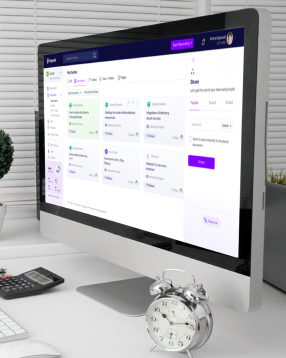Explore the detailed comparison between Kopyst and Loom. Discover their features, video guide capabilities, document creation, editing tools, and more to determine which tool is ideal for your video tutorials and how-to videos.

Kopyst is designed to be a versatile solution for any industry. Whether you’re an individual content creator, a freelancer, or part of a large enterprise, Kopyst equips you with the tools needed to create comprehensive video guides, tutorials, and how-to videos. Unlike traditional video communication tools, Kopyst also supports the creation of document guides and online documents, offering a holistic approach to content creation. Users can easily record and upload videos, images, and audio, with the option to integrate camera footage, making it a powerful platform for producing multimedia content.
Loom, is well-known for its simplicity and efficiency in creating quick video tutorials and messages, especially within team settings. It’s a go-to tool for professionals who need to communicate ideas swiftly and effectively, with minimal editing required. While Loom excels in video communication, it doesn’t offer the same level of depth in terms of document creation and advanced editing features as Kopyst.
Video Guide Creation and Document Support
Kopyst and Loom both excel in video creation, but Kopyst offers additional features that extend its usability into document creation and multimedia integration.
With Kopyst
With Loom
Create professional video guides with Kopyst or Quickly share tutorials with Loom today!
Kopyst offers a more robust set of video editing tools compared to Loom, making it ideal for creating polished, professional-quality content.
Includes advanced editing features such as cutting, merging, adding captions, text boxes, audio uploads, zoom in/out, and applying blur effects to confidential information. These features allow users to create high-quality, detailed video guides and tutorials tailored to their specific needs.
Provides basic editing options, such as trimming and simple annotations. Loom is designed for quick, straightforward video creation, making it a great choice for users who need to produce and share content rapidly.
Both Kopyst and Loom excel in sharing and collaboration, but they cater to slightly different needs.

Allows users to share their videos privately, collaborate with teams, and post directly to social media. Premium members can download full videos or specific parts as standalone videos or GIFs, providing flexibility in content distribution.
Focuses on easy sharing via links, making it convenient to send quick video messages within a team. While Loom supports social media sharing, it offers fewer customization options compared to Kopyst.
Collaborate effectively with Kopyst or Quickly share with Loom.
Both Kopyst and Loom offer flexible pricing plans to accommodate different user needs. Here’s a breakdown of what each tool provides
Kopyst
Loom
Compare Kopyst’s pricing and Explore Loom’s pricing to determine the best fit for your needs.
Kopyst and Loom both provide strong customer support, but they cater to different types of users.
Offers extensive support through email, a comprehensive knowledge base, and a community forum where users can share tips and solutions. Kopyst is well-suited for users who need in-depth guidance on creating and editing videos.
Provides streamlined support through its help center, email, and an active user community. Loom’s support is tailored towards users who need quick assistance with video recording and sharing.
Here’s a quick overview of the main advantages and disadvantages of each tool:
Pros
Cons
Pros
Cons
Choosing between Kopyst and Loom depends on your specific needs and goals. Here’s a quick guide to help you decide
Choose Kopyst if:
Choose Loom if:
A – Kopyst is designed for creating comprehensive video guides, tutorials, and how-to videos with advanced editing features, document creation, and customizable templates. Loom is more focused on quick video recording and sharing, particularly for team communication, with simpler editing tools.
A – Kopyst is ideal for content creators, educators, freelancers, and enterprises that need a versatile tool for creating detailed video guides and tutorials. It offers more extensive editing and customization features compared to Loom.
A – Loom is perfect for professionals and teams who need to create and share quick video messages and tutorials. It’s best suited for those who prioritize ease of use and fast distribution over in-depth video editing.
A – Yes, Kopyst allows users to create both video guides and document guides, including online documents. This makes it a comprehensive solution for digital content creation and training
A – No, Loom does not offer video templates. Kopyst provides customizable templates to help users create polished, professional-quality videos quickly.
A – Yes, Kopyst offers advanced video editing features, including cutting, merging, adding captions, text boxes, audio uploads, zooming, and applying blur effects for confidential information. These tools allow users to refine their videos before sharing.
A – Yes, both tools support team collaboration, but in different ways. Kopyst allows users to collaborate on video projects, share content privately, and distribute it on social media. Loom focuses on quick sharing and team communication via video links.
A – Both Kopyst and Loom offer free plans with basic features. They also provide paid plans that unlock additional capabilities, such as advanced video editing in Kopyst or enhanced sharing options in Loom. For specific pricing details, it’s best to visit their respective websites.
A – Yes, both Kopyst and Loom offer free versions of their platforms. This allows you to explore their features and decide which one best suits your needs. Try Kopyst or Loom today and find out which one works best for you.
Both Kopyst and Loom bring unique features to the table, catering to different user needs. Whether you’re looking to create in-depth video tutorials or need a quick solution for video communication, these tools have you covered. By understanding your specific requirements, you can choose the tool that best supports your workflow and content creation goals.